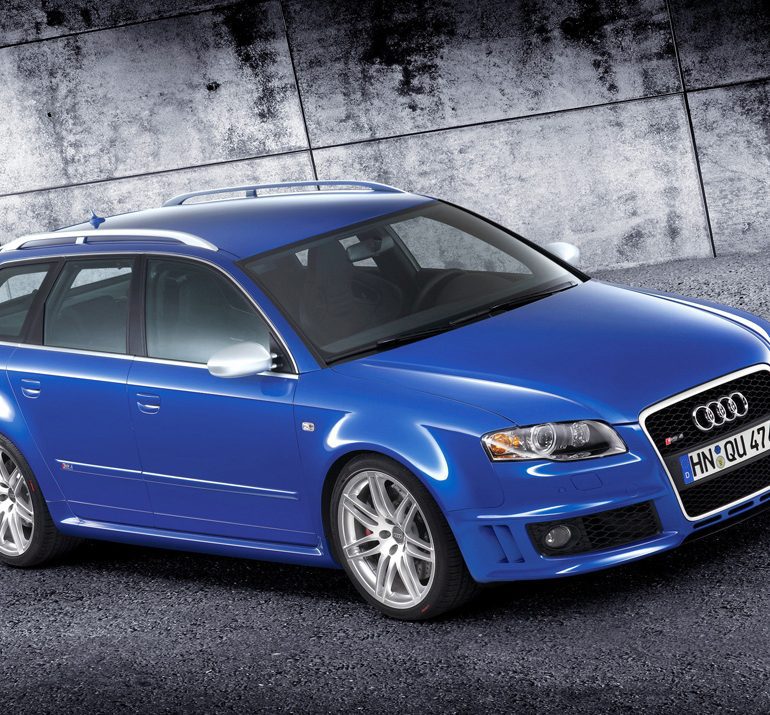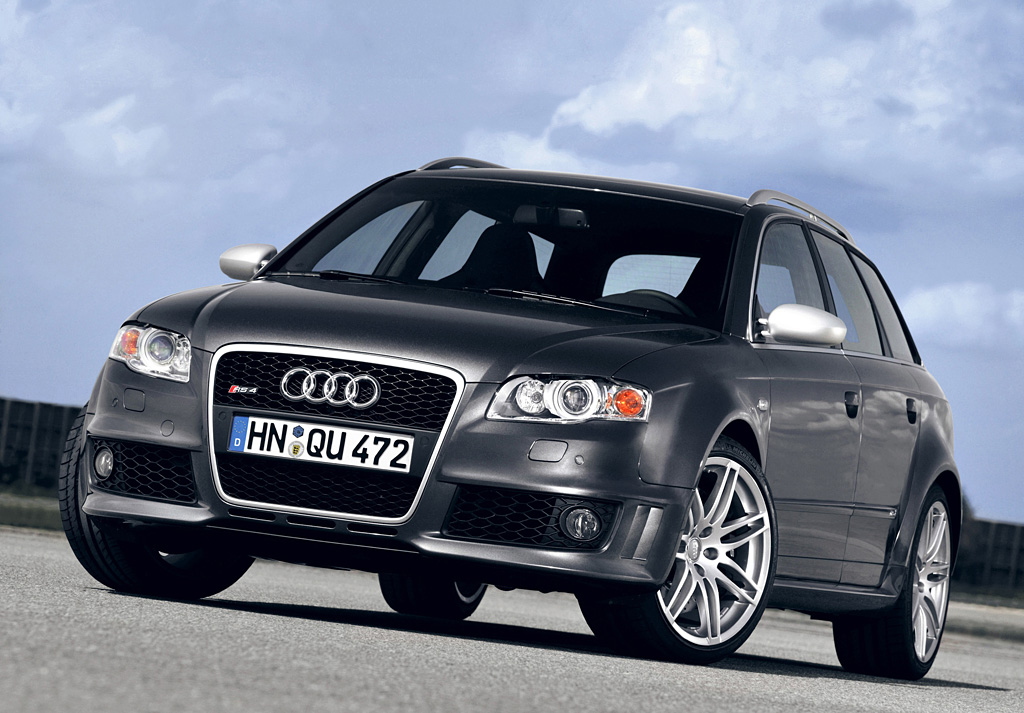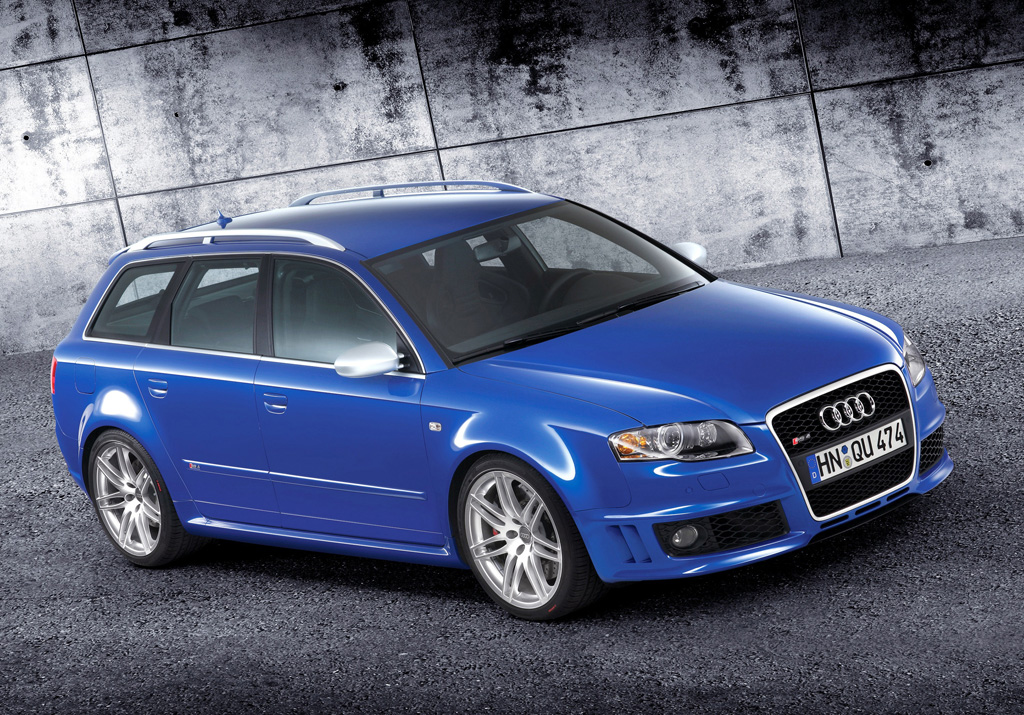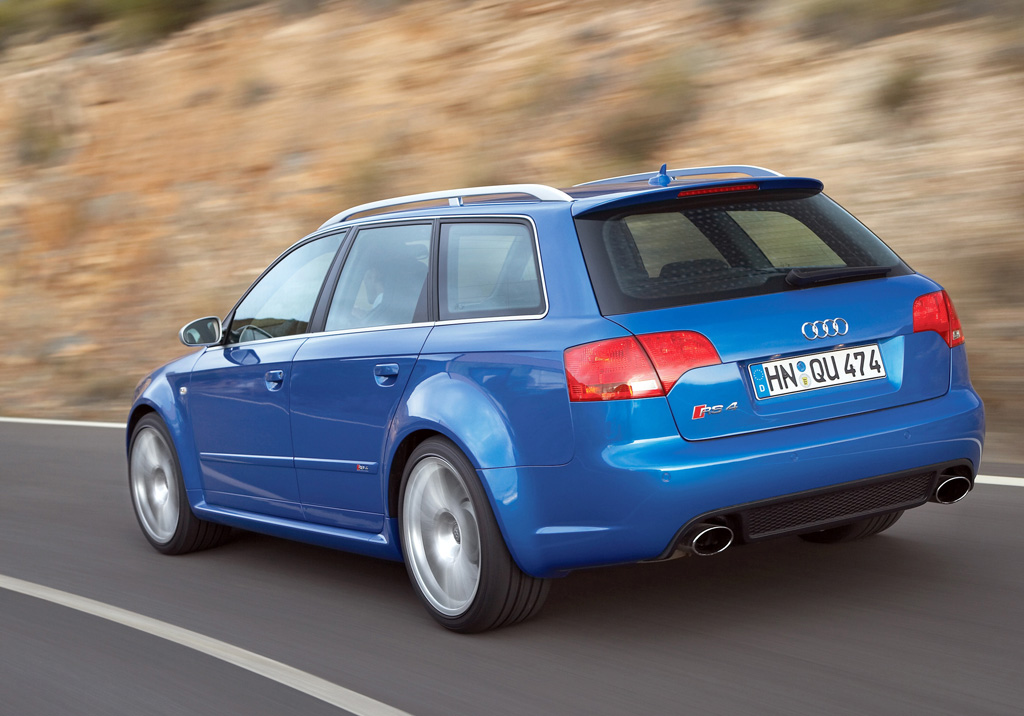2006 Audi RS 4 Avant
From this summer, Audi will for the first time be offering additional versions of the RS 4. Following the successful market launch of the saloon at the end of last year, the Avant and Cabriolet versions will be appearing at dealers from the summer. This will round off the RS 4 family. This highly emotionally charged, high-performance product from quattro GmbH unites the characteristics of a sports car with supreme everyday qualities. This is as true of the saloon version as it is of the Avant and the four-seater Cabriolet.
The RS 4 has numerous new features to distinguish it. Most notably, there is the V8 engine with an output of 420PS. This is the first time that a manufacturer has combined petrol direct injection with a high-revving concept. Engine speeds of up to 8,250 rpm are possible. Another highlight is the suspension with the latest generation of quattro permanent four-wheel drive and Dynamic Ride Control. The Cabriolet and Avant have likewise been subjected to a rigorous regime of weight reduction measures to make sure that they are equally sporty. Even though the engineers have systematically applied lightweight construction principles, all RS 4 versions feature luxurious equipment that singles out the Audi RS 4 as a high-performance vehicle suitable for everyday driving.
The Audi RS 4 Avant
Beautiful estate cars are called Avant. A maxim that is equally applicable to the Audi A4 and to the new top model, the RS 4 Avant. In it, Audi combines the characteristics of a sports car with the practical virtues of an Avant.
Racing technology clad in civilian garb: a principle that applies both to the RS 4 Avant and to its saloon counterpart. The first RS 4 generation was available exclusively as an Avant, because it was clear that there was market demand for that body version.
Although in production for only slightly more than one and a half years, sales of the first-generation RS 4 Avant topped 6,000 units. Incentive enough to include this attractive body version in the range again.
There are numerous new features that give the RS 4 Avant a distinctive flavour while still identifying it as a member of the A4 family. The single-frame radiator grille with a rhombus-pattern grid, the additional air inlets at the front end and the alloy wheels developed specially for the RS 4, together with the flared wheel arches, clearly set the Audi RS 4 Avant apart from a standard A4. Flared sills and lower door trims coordinated with the sills are other differentiating features. Then there are the RS 4 badges at the front and rear, as well as on the side rubbing strips.
Over and above providing visual accents, the rear apron with the two large, oval tailpipes and the subtle but effective roof spoiler are actually highly functional. Another example: the ride height of both the Audi RS 4 Avant and its saloon counterpart is 30 millimetres lower than that of the standard A4. To accommodate this change, the track of both axles has been widened. The car not only sits more unwaveringly on the road as a result, but also handles better.
Attractive and convenient: the RS 4 Avant’s load area combines an exclusive atmosphere with optimum usability and a versatile layout. The successful interior design and multifunctionality set new standards in this class. The variable load-area floor provides generous storage capacity. It can be opened wholly or in part, or removed altogether. The low loading lip and smooth side edges facilitate loading of objects of up to one metre in width. The smooth-surfaced inner side panels have no bulges, making the load area look extremely tidy at all times. A full range of ingenious details such as a net for small items and lashing points enhance the practical utility of the Audi RS 4 Avant.
A virtually level load area is created by folding down the divided rear seat. The luggage cover and load guard are housed in a space-efficient housing that can be folded away together with the seat back.
With its functionality and outstanding driving characteristics, the new Audi RS 4 Avant is not only a worthy successor to the first generation, but surpasses it in every respect. Even more sporty, spellbinding and practical: this Avant is a very special car.
Engine
The 420PS V8 revs up to a speed of 8,250 rpm. With its displacement of 4,163 cm3, this outstanding engine breaks through the magic barrier for a production saloon of 100 bhp per litre. The highly compact power unit reaches its peak torque of 430 Nm at 5,500 rpm. At least 90 percent of the maximum torque is available between 2,250 and 7,600 rpm. The result is excellent pulling power at all times, enabling the driver to drive in a relaxed style without frequent gear changes.
Audi’s RS 4 saloon employs groundbreaking FSI technology. The petrol direct-injection unit delivers enhanced power output based on more efficient combustion of the fuel/air mixture. The engine is also more responsive. The performance of the RS 4 clearly demonstrates this progress: it reaches the 100 km/h mark in 4.8 seconds (Avant 4.9 seconds, Cabriolet 4.9 seconds), and 200 km/h in 16.6 seconds (16.9 seconds; 17.5 seconds). On all three versions, the speed is governed electronically when the needle reaches 250 km/h.
Audi has deployed the high-revving engine principle for the first time in the RS 4. The advantages of this principle are superior power output at high engine speeds, a smooth power flow and eager responsiveness all across the revs range. Further fortes are the car’s outstanding agility and fast-revving response as well as the kind of racing-style engine sound that drivers of such cars simply expect.
As a result of these qualities, the eight-cylinder power unit provides maximum thrust and performance in virtually all driving situations. The constant flow of power from bottom-end speeds all the way up to 8,250 rpm is equally appropriate for a relaxing driving style with minimum gearshifting and for exploits worthy of the racetrack.
The V8 power unit is ultra-compact in its dimensions, fitting snugly into the engine compartment of the RS 4 without necessitating any modifications to the body. The camshaft and ancillaries, with the exception of the alternator, are all driven by a chain for easy maintenance. An all-new development, the eight-cylinder unit powering the RS 4 includes such features as modified pistons and con rods, a new crankshaft together with its bearings, and new cylinder heads.
A dual-branch exhaust system with enlarged pipes provides even higher power output. These extensive measures have enabled the 4,163 cm3 engine to break through the magical 100PS per litre barrier.
The car’s power-to-weight ratio is also impressive: 254PS per tonne is a figure that only the most thoroughbred sports cars were able to offer just a few years ago. The figure for the Avant is only slightly higher.
Drivetrain
Audi translates the engine’s power into locomotion in typical style: the latest generation of quattro permanent four-wheel drive, which featured first in the RS 4 saloon and offers a asymmetric/dynamic torque split of 40 (front axle) to 60 (rear axle) in conjunction with the self-locking centre differential, is one of the main reasons why the RS 4 is still able to provide traction when other drive concepts have long since reached their limits. quattro drive is further enhanced by the DRC suspension system (Dynamic Ride Control), which significantly reduces the rolling and pitching movements of the vehicle about its transverse axis and rear axle.
The 30 millimetre lower ride height compared with an Audi A4, the wider track at the front and rear axle and the sporty spring and damper settings help the RS 4 to meet the developers’ ambitious handling objectives and place it in the realm of a genuine sports car.
The brakes, too, represent new dimensions in their innovation. Floating, perforated, ventilated brake discs measuring 365 millimetres in diameter are fitted at the front, and there are likewise perforated, ventilated brake discs at the rear with a diameter of 324 millimetres. The specifically flow-enhanced brake ventilation incorporating NACA ducts on the underbody of the car ensures optimum cooling of the brakes, however high a load they are subjected to.
The latest generation of ESP has been modified specifically to suit the particular properties of this high-performance vehicle. It now intervenes later and for shorter periods. It is also possible to disable the ESP in two stages. In the first stage only the traction control (ASR) function is disabled; the other ESP functions remain fully active. In the second stage the ESP is completely deactivated, including the traction control. All electronic control then ceases.
The servotronic steering has been specially tuned to the requirements of a sports car. With its direct response and short travel, it is outstandingly well suited to the overall character of all RS 4 versions.
Audi has likewise adapted the six-speed gearbox to the handling requirements of a sports car. With its precision navigating through the shift gate and its short travel, it enhances driving pleasure and prompts the driver to change gear more often than the universally free-revving engine actually needs.
Light and comprehensive
Although weight was one of the main considerations in the development of the Audi RS 4, the car boasts an extensive range of equipment. Standard features include a deluxe automatic air conditioning system, as well as the concert radio system.
Central locking and electric windows are also featured as a matter of course in a car of this class. The Audi parking system at the front and rear helps avoid irritating dents and scratches when parking.
The high-intensity xenon plus headlights provide optimum visibility. The RS logo is worked into the flat-bottomed RS sports steering wheel as well as into the seat upholstery and door sills.
Two of the functions controlled directly from the ergonomically designed RS sports steering wheel are the lap timer and the Sport button. Dynamic Ride Control (DRC) provides sporty, dynamic handling by significantly reducing body roll and pitch, while nevertheless providing an exceptionally high standard of ride comfort for a sports car. All RS 4 models come with 18-inch cast aluminium wheels of 5-spoke design. As an optional extra, there are 19-inch wheels of a double 7-spoke design. Here, too, weight saving is combined with sporty design.
There are countless echoes of motor racing around the interior of the RS 4 models. These include the extensive use of carbon fibre and aluminium. The engine is started at the push of a button.
In the saloon and Avant, the front passengers are accommodated on sports bucket seats. These provide maximum support even when the car is driven energetically, for instance round a racetrack. On these seats, the width of the seat base and seat back can be adjusted electrically as preferred. Even greater lateral support can be obtained by pressing the Sport button. As well as calling up a modified, more spontaneous throttle response and an even more sporty sound from the exhaust system, this function inflates the seat side sections, supporting the driver even more securely.
The Cabriolet is equipped with leather-upholstered sports seats, which likewise provide very good support but also take the higher comfort requirements of Cabriolet drivers into account. Here too, RS bucket seats are available as an option.
Audi offers an extensive range of optional extras for the RS 4. They include the navigation system plus and the symphony radio system. On the RS 4 saloon and RS 4 Avant, various exterior mirror versions (optionally also with fold-in function), the sports suspension plus and the comfort package are also available. This comfort package comprises features such as cruise control and heated front seats.
For customer preferences above and beyond this range, quattro GmbH offers an extensive customisation service by the name of Audi exclusive.
In Detail
| type | Series Production Car |
| built at | Germany |
| predeccesor | 2012 Audi RS 4 Avant |
| succeccesor | 2000 Audi RS 4 Avant |
| engine | V8 90º |
| position | Front Longitudinal |
| aspiration | Natural |
| ignition | Coil-On-Plug |
| block material | ALUSIL Aluminium-Silicon Alloy w/Silicon Crystal Liners |
| valvetrain | DOHC 4 Valves per Cyl w/2-Stage Variable Intake |
| fuel feed | FSI Direct Injection |
| displacement | 4163 cc / 254.0 in³ |
| bore | 84.5 mm / 3.33 in |
| stroke | 92.8 mm / 3.65 in |
| compression | 12.5:1 |
| power | 309 kw / 414.4 bhp @ 7800 rpm |
| specific output | 99.54 bhp per litre |
| torque | 430 nm / 317.2 ft lbs @ 5500 rpm |
| redline | 8250 |
| body / frame | Unit Steel |
| driven wheels | Quattro 4WD w/Torsen Centre Differential, DRC Dynamic Ride Control |
| wheel type | Cast Alloy |
| front tires | 255/35ZR-19 96Y Pirelli P Zero Rossa |
| rear tires | 255/35ZR-19 96Y Pirelli P Zero Rossa |
| front brakes | Cross-Drilled & Inner-Vented Discs w/8-Piston Calipers, ABS, ESP, EBD |
| rear brakes | Cross-Drilled & Inner-Vented Discs w/Single Piston Sliding Caliper, ABS, ESP, EBD |
| front wheels | F 45.7 x 20.3 cm / 19 x 9 in |
| rear wheels | R 48.3 x 22.9 cm / 19 x 9 in |
| steering | Rack & Pinion w/Power Assist |
| f suspension | Double Wishbones w/Anti-Roll Bar |
| r suspension | Trapezoidal-Link w/Anti-Roll Bar |
| transmission | 6-Speed Manual or Tiptronic |
| gear ratios | 3.667:1, 2.050:1, 1.462:1, 1.133:1, 0.919:1, 0.778:1 |
| final drive | 3.889:1 |







